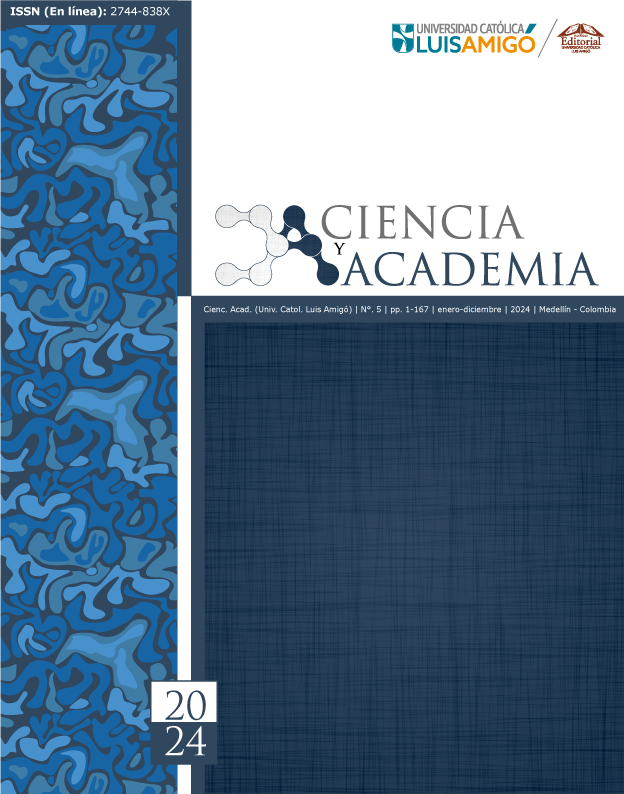The creatio ex nihilo and the Rationes seminalis in agustinian cosmology
DOI:
https://doi.org/10.21501/2744838X.4555Keywords:
Ontology, Cosmology, Creationism, Saint Augustine of Hippo, Creatio ex nihiloAbstract
The thought of saint Agustín of Hipona coats a special burden regarding to the considerations around the explication of the origin of the world, his creation, his
formation and his consolidation. For this reason this article is proposed to investigate about the ontological and philosophical basics of the augustinian theory of the
creation, divided into two moments: a) the recognition of the meaning of creatio ex nihilo and the ratio seminalis as a neuralgic concepts in the creationists theory of saint Agustin and b) the analysis of the same concepts in the light of two moments or senses identified for the environment of the narration of the creation. Recurring
to the twelfth book of Confessions and many books of De Genessi ad literam are identified that although in principle saint Agustín find a narrative problem between the introduction and rationale of the concepts mentioned allow you to understand the creation as an voluntary act from God in the same moment (simultaneous creation) expressed in two different parts, no in temporary terms, otherwise, casual terms.
Downloads
References
Alesanco, T. (2004). Filosofía de San Agustín. Síntesis de su pensamiento. Editorial Avgvstinvs.
Armstrong, A. H. (1966). San Agustín y la transmutación del pensamiento antiguo. En: Introducción a la filosofía antigua. Viamonte.
Arranz, M. (2004). Doctrina agustiniana de la creación virtual. Reflexiones de un micólogo sobre el origen de la diversidad biológica. En C. V. Vicente Domingo (Ed.), San Agustín: 1650 aniversario de su Nacimiento. (pp. 101-121). Centro
Teológico San Agustín.
Aristóteles (1995). Libro III. Física (G. R. De Echandía, Trad.). Gredos.
Bassols, L. (2007). Vida, pensamiento, y obra de San Agustín. Planeta DeAgostini, S.A.
Benavides, V. (2008). La evolución intelectual de la noción de materia en san Agustín de Hipona. Scripta Medievala, 1, 35-49. http://revistas.uncuyo.edu.ar/ojs/index.php/scripta/article/view/469
Benavides, V. (2007). Algunas consideraciones sobre la visión agustiniana del universo y su vigencia en el pensamiento cosmológico contemporáneo. Intus–Legre Filosofía 1(1), 45-57. https://doi.org/10.15691/0718-5448Vol1Iss1a28.
Ibarreta de Ghío, O. M. (1975). La noción de materia en San Agustín. Patristica Et Mediævalia, 1, 77-81. http://revistascientificas.filo.uba.ar/index.php/petm/article/view/7940.
Maluf, A. (2013). Creación y razones seminales en san Agustín. Stadium. Filosofía y Teología 16(32), 255-263. https://revistas.unsta.edu.ar/index.php/Studium/article/view/453.
Moreau, J. (1964). El tiempo y la creación según San Agustín. Espíritu, 13, 104-117. https://dialnet.unirioja.es/servlet/articulo?codigo=7513953
Pegueroles, J. (1972). El ser y el tiempo. En: El pensamiento filosófico de san Agustín. Labor.
Pérez de Laborda, A. (2002). El mundo como creación. Comentarios filosóficos sobre el pensamiento de San Agustín en el DE GENESI AD LITTERAM. En: El mundo como creación. Ensayo de filosofía teológica. Ediciones Encuentro, S.A.
Pierantoni, C. (2002). Dios y la materia: Propuesta a partir del Timeo de Platón y las Confesiones de San Agustín. Teología y Vida, 44(2-3), 330-342. http://www.redalyc.org/articulo.oa?id=32217004019
Platón. (1998). Filebo, Timeo, Critias (M. A. Durán & F. Lisi, Trad). En Timeo. Gredos. (Obra original publicado en 1992).
Plotino. (s.f.). Enéada (V. J. Igal, Trad.) En Enéadas V-VI. Gredos.
Safranski, R. (2005). El mal o el drama de la libertad. Fabula Tusquets.
San Agustín. (1957). Del Génesis a la letra (Fr. B. Martin, Trad.). En Obras de San Agustín. (Vol. XV). BAC.
San Agustín. (1957). Del Génesis contra Maniqueos (Fr. B. Martin, Trad.) En Obras de San Agustín (Vol. XV). BAC.
San Agustín. (1974). Libro duodécimo (A. Custodio Vega, Trad.). En Las confesiones (7a edición). BAC.
San Agustín. (2012). Libro XI (R. M. Marina, Trad.). En Ciudad de Dios. Gredos.
Published
How to Cite
Issue
Section
License
Copyright (c) 2024 Ciencia y Academia

This work is licensed under a Creative Commons Attribution-NoDerivatives 4.0 International License.
La revista y los textos individuales que en esta se divulgan están protegidos por las leyes de copyright y por los términos y condiciones de la Licencia Creative Commons Atribución-No Comercial- 4.0 Internacional. Permisos que vayan más allá de lo cubierto por esta licencia pueden encontrarse en http://www.funlam.edu.co/modules/fondoeditorial/






